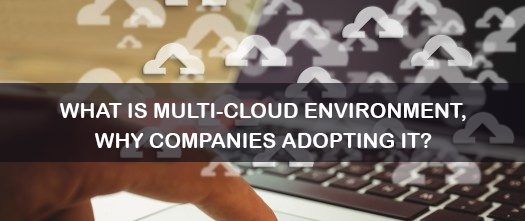What is Multi-Cloud Environment, Why Companies Adopting it?
Have you ever wondered how companies manage all their data and information? The answer lies in the key of Multi-Cloud Environment—an innovative yet planned strategy adopted by businesses to handle their digital needs.
Now-a-days, companies don’t just rely on one place to store all their important stuff online; instead, they use several different clouds from various providers. This Multi-Cloud Environment allows them to spread their data across different platforms, making it more secure and flexible.
But, why are companies opting for this digital shift?
The answer lies in the increasing demands for efficiency and security. By using multiple cloud services, companies reduce the risk of losing data if one system fails. It’s like having a backup plan; if something goes wrong with one provider, they can quickly switch to another without losing important information. This strategy also helps companies tailor their services by choosing specific cloud providers for specific tasks, ultimately improving their overall performance.
If you’re a tech enthusiast or a non-tech fresher or learner, understanding Multi-Cloud setups is like having a golden ticket to the job market of tomorrow. Since companies are banking heavily on these systems, expertise in handling the multicloud environment skills can be your gateway to a well-established and lucrative career.
For all those who want to learn more about multi-cloud environment, this blog has all the details for you. Scroll down to explore!
Overview About Multi-Cloud Environment
Multi-Cloud is an advanced cloud computing strategy where organisations use the services from different cloud providers simultaneously. Instead of relying on a single cloud stack, this approach involves integrating two or more public clouds, multiple private clouds, or a blend of both.
What Multi-Cloud Offers:
- Flexibility and Freedom: Multi-Cloud empowers organisations to craft strategies by precisely selecting capabilities from diverse vendors, catering specifically to their unique business requirements. This reduces the risk of vendor dependency, ensuring adaptability and agility.
Growing Adoption and Solutions:
- Rising Popularity: The concept of Multi-Cloud is gaining popularity as businesses seek optimised solutions that escape complexity while deploying applications where needed.
- Leveraging Technologies: Solutions based on open-source platforms like Kubernetes offer the requisite flexibility to migrate, build, and optimize applications across various cloud environments.
Benefits Driving Adoption:
- Compatibility with Emerging Technologies: Multi-Cloud seamlessly integrates with DevOps practices, containers, and microservices architecture, facilitating portability and application optimization.
- Maximising Efficacy: Leveraging multiple cloud providers instead of sticking to a few enhances business efficiency and minimizes reliance on limited resources.
Strategic Imperatives for Businesses:
- Competitive Edge: The future outlook necessitates a Multi-Cloud strategy for businesses aiming to stay competitive and responsive to evolving technology spaces.
- Customized Approach: By adopting Multi-Cloud, companies can strategically choose cloud providers that align best with their distinct needs, goals, and workload demands.
In the ongoing pursuit of digital transformation, a Multi-Cloud architecture emerges as a safer and reliable solution, ensuring a diverse range of specialist services, robust security, optimized performance, and cost-effectiveness. With around 90% of companies already integrating this strategy, the Multi-Cloud approach remains essential in driving innovation and competitiveness.
Why are Businesses Adopting a Multi-Cloud Environment?
1. Flexibility in Service Selection:
Choosing the best cloud services for each specific task without being locked into a single provider. It’s about having the freedom to cherry-pick services that perfectly match the requirements, capabilities, and pricing models needed for each workload.
2. Enhanced Redundancy and Disaster Recovery:
Distributing workloads across multiple clouds ensures continuity. In the event of service disruptions, swiftly switching to an alternate cloud provider becomes seamless, minimizing downtime and keeping operations afloat.
3. Optimised Spending:
By comparing pricing models and selecting the most cost-effective option for each workload, companies efficiently manage their cloud spending. It’s about cutting unnecessary expenses and maximizing returns by choosing the most affordable services for specific tasks.
4. Improved Performance:
Leveraging different clouds enables companies to tap into each provider’s unique strengths. This translates into better performance for specific workloads, efficiently allocating resources where they are needed most and elevating the overall user experience.
5. Encouragement of Innovation:
Accessing multiple cloud providers opens doors to the latest technological innovations. Experimentation with new technologies becomes easier without committing to a single provider. This helps companies stay ahead by adopting the latest advancements in cloud computing.
Real-World Examples of Successful Multi-Cloud Implementations:
Netflix:
Netflix, a leading streaming service, employs a multi-cloud approach to power its platform. By leveraging multiple cloud providers, Netflix achieves scalability and cost-effectiveness in delivering seamless streaming experiences to millions of users worldwide. The strategy enables them to optimize their operations and manage varying workloads efficiently.
BMW, Walmart, and BP:
Beyond software-focused industries, renowned entities like BMW, Walmart, and BP from traditional sectors have embraced cloud computing to innovate and streamline operations. These established companies leverage multi-cloud strategies to drive innovation and enhance operational efficiencies. For BMW, it might involve integrating cloud technologies into vehicle manufacturing processes, while for Walmart and BP, it could mean leveraging cloud solutions for supply chain management and energy exploration, respectively.
These diverse implementations showcase the adaptability and benefits of multi-cloud adoption across different industries, solidifying its relevance and impact beyond the realm of digital services.
Predicting Multi-Cloud Environment Future After 2023 Adoption
Lots of companies are using Multi-Cloud feature, and have claimed this to be a helpful approach for their increased efficiency and security. Moreover, looking ahead, it seems like more and more companies will start using Multi-Cloud too.
What’s Making More Companies Interested?
People think Multi-Cloud is going to become even more popular because it helps get better services, saves money, and makes following the rules easier. If companies start using Multi-Cloud now, they can store data safely, make it bigger if needed, and not spend too much.
Big Changes in the Tech World:
Multi-Cloud is going to change how computers work in big ways. It’s going to become super important for companies to handle and organize their computer stuff.
What Companies Need to Do:
Some companies want to use Multi-Cloud but aren’t so sure how to do it well. They’re trying to make their computer systems better to use Multi-Cloud. They want more options and better ways to do their work quickly.
Tips for the Future:
Success with Multi-Cloud depends on having the right tools and expertise. By harnessing the potential of multiple Cloud Service Providers (CSPs), companies can develop adaptable solutions suitable for various environments.
Ultimately, Multi-Cloud will maintain its significance. Companies must prepare for tech advancements, leveraging Multi-Cloud to evolve and thrive in the digital landscape.
Conclusion
As we step into the future of technology, enhancing or brushing up Multi-Cloud strategies isn’t just a trend but a critical aspect of staying relevant. The evolution of computing demands a deep understanding of Multi-Cloud environments to remain at the forefront of innovation and efficiency.
To ensure you’re equipped for this dynamic landscape, it’s crucial to invest in learning Multi-Cloud technologies. Grras Solutions stands as a reliable educational platform offering comprehensive courses in cloud computing and other technical domains. By enrolling in Grras Solutions for cloud computing training, you gain access to cutting-edge knowledge, empowering you to not only adapt but also lead the charge towards a digitally transformed future.
Connect with the IT experts at Grras Solutions now to know more.






